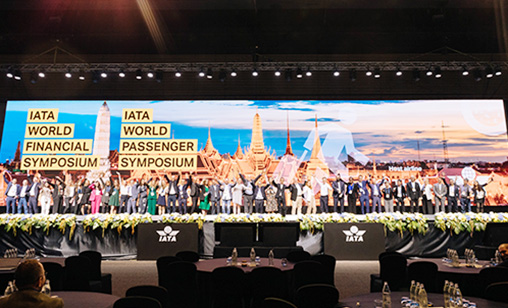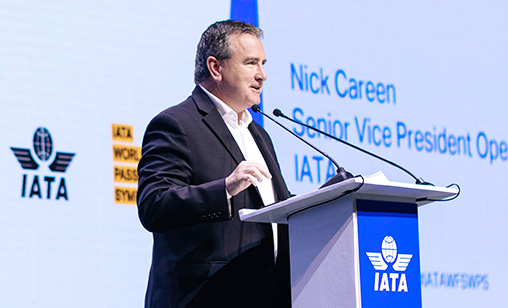Main Story
Time to abandon obselete revenue models
Sweeping digital change is necessary if airlines are to meet next generation passenger demands, reports Tomasz Sniedwiewski from Bangkok.
October 1st 2024
Mostly, when people hear the word innovation in the airline industry, they imagine new aircraft types or updated cabin products and services. Read More » But for delegates attending the International Air Transport Association (IATA) World Financial Symposium (WFS) & World Passenger Symposium (WPS) in Bangkok last month, “innovation” was about the new world of Offers and Orders where the customer is the centre of the transaction.
This radical shift, where the passenger will manage all stages in an airline journey might not be as visible to the general public as other technological changes sweeping the world, but it is just as profound.
 |
“We are at the center of time. The whole industry is looking into the most important and the most massive transformation in its history,” International Air Transport Association (IATA) senior vice president, financial settlement & distributions. Muhammad Albakri, told Orient Aviation in Bangkok.
“Since their beginnings, airlines have been operating on specific policies, procedures and standards. The standards glue the stakeholders together. They bring clarity. They bring transparency. They allow different stakeholders to know their roles, that is capture data and format how it is processed and hand it on to the next player,” he said.
“These standards were developed 40-50 years ago. They kept the industry going for so long, but the world is different. The thinking is different and customer expectations are totally different.
“Maybe before people were looking for a means of transportation from point A to point B. Now customers have many more desires, needs and expectations than just movement.”
And this transition, the world of Offers & Orders, should take place by 2030, Albakri said.
“We estimate 70% of existing aviation standards have to be rewritten, hopefully in a much more simplified manner than in the past,” he said.
 |
“The endpoint is to move from PNR (Passenger Name Record) to Offers and Orders, where the customer is not a record,” Albakri said, adding the current technology is “extremely expensive, extremely costly in operational costs and does not allow airlines to swiftly and flexibly offer new services and products to their customers”.
IATA’s NDC Standard, introduced 11 years ago, has partly improved the situation, he agreed. “Still we process e-tickets and PNRs. We process numbers. We do not manage people or customers,” he said.
“Our biggest challenge is to move from managing numbers and records to managing customers and delivering their expectations. This is the promise of Offers and Orders,” he said.
In the new reality Albakri envisages, passengers will decide who will receive and share their data from their digital wallets. It will include airlines, immigration and customs departments, security authorities, even hotels.
All the identity data necessary for their journeys will be in one place, removing the need for separate records for each step of an airline journey.
“If governments work together to implement solutions it will be of immense benefit to airlines and customers,” IATA senior vice president operations, safety and security, Nick Careen, said, listing right off the bat the potential benefits of reduced paper costs, reduced transit time and seamless travel.
IATA also believes digitalization will reduce crew working time and better utilize aircraft schedules.
 |
“There are efficiency gains for the airlines. There are improvements in customer services. There are opportunities to increase loyalty, so it’s a win-win,” Careen said.
The International Civil Aviation Organization (ICAO) has written a standard for digital travel, but until now governments decide if they will implement it, Careen said, adding the pandemic has accelerated adoption.
“It got us a few years ahead of where we would have been. Governments were keen to develop a digital identity for travellers beyond the airport,” he said.
“It is probably not completely harmonized yet, not as interoperable as you would like, but largely it is implemented and available globally. My guess is that by 2030 we will see widespread usage worldwide.”
A roadmap of the changes younger generations of air passengers want will be shaped by the latest IATA Global Passenger Survey which was released at the Bangkok World Passenger Symposium.
Survey respondents said they expect convenience and speed when traveling and a smoother travel experience.
They are eager to adopt biometric identification and complete travel processes before arriving at the airport.
The International Air Transport Association (IATA) , Senior Vice President, Financial Settlement & Distribution Services. Muhammad Albakri, told Orient Aviation: “I think the Asia-Pacific will lead the world [in this transition] because the people and the public are so used to digital services, so used to having apps in their phones. They are so used to using technology to manage their lives, needs and experiences. So whenever airlines move into digitalization and start offering services through digital means, from payments, from booking, from buying, from traveling, this region will leverage a known familiarity and the convenience the people in the region are already used to. “I have been watching the Asia-Pacific and North Asia, especially when it comes to digital payments. These regions are way more advanced than any other region in the world. It gives us a lot of hope that when airlines move into this area, it will be a seamless transition.” Last month, IATA announced it will offer digital currencies in the financial settlement systems it operates for the industry. The first digital currency to be offered will be the digital Renminbi. It will be available in the China Billing and Settlement Plan (BSP) by the end of 2024. “That speaks for itself. Why we went there? Because the country is ready. The infrastructure is ready. People want it. The regulator wants it. The airlines wanted it. So we did offer it to them,” Albakri said. |
Asia-Pacific passengers lead the world in use of mobile apps and digital wallets for their travel. They also are more likely to accept biometric technology at airports, although their satisfaction with the experience is the lowest of all regions surveyed.
The region’s air travelers also are the most price-conscious when choosing their departure airport.
The 2024 GPS identified a new and distinctive group of passengers: they are aged 25 or younger and are considerably more proactive in using technology to improve their travel experience.
“That is the coolest part of this survey. Things pop out. There are enough people from this demographic to appear in the survey,” Careen said.
The positives of a digital transition at airlines reverberated with audiences at the conference. Delegates, of which a majority was finance executives at airlines, focused on the practical aspects of implementing such radical change.
| 'Consumers are telling us they want to be able to spend. They want the payment process to be quick and simple. Sort of like clicking for an Uber. They want to check for the services they want, to tailor their journeys' |
For example, how do they communicate the need to change to top airline management? Or to other departments at their airlines?
A big part of the symposium’s seminars was sharing the feedback and experienced of 12 airlines in various stages of implementing Offers & Orders.
There was a wide consensus among participants that airlines need to move to the new standards. “If we started out in business today, we would organize it exactly in this new way”, was the often shared opinion.
The discussions examined the best methods of implementing the new processes.
“If we need to eat an elephant, we need to do it piece by piece”, a panel member, Turkish Airlines chief information officer, Kerem Kiziltunec, said.
The knowledge-sharing process is crucial because IATA has not set a deadline for making the shift to a passenger centric process.
“Some airlines have started. Some will start in 2025. There will be others following later,” Albakri said.”
Referring back to the new passenger survey, Careen was asked if there is one message he would like airlines to take from the responses.
“My immediate go-to would be operations as my background is operations, but the most obvious area of focus will be the payment process,” he said.
“Airline margins are so low, 6% on average, that any chance to increase revenue, to help the bottom line, will expedite all the other good benefits we have on our list.”
“It is why airlines should do anything to accommodate this, even if it means splitting the payment half-half between different forms, such as credit cards and a digital wallet.“We should not make it a blocker and today it is a blocker.”
| Generation gap. A different kind of passenger Under 25s are driving demand for digital control of their journeys. Around 51% of air passengers aged 25 would choose digital wallets for travel payments, far more than the global average of 20%. Approximately 90% of this age demographic expressed interest in a smartphone with a digital wallet and passport and loyalty cards to pay for bookings and airport navigation. The global average is 77% IATA’s latest global passenger survey shows. Approximately 48% of this group prefers biometrics to traditional passports and boarding passes compared with 43% of survey respondents aged 56-75. Additionally, 50% of under-25s surveyed would be open to biometric solutions for air travel, if they could be assured of data security, against a global average of 39%. “The former are going to drive change. They are the generation wanting to experience things,” IATA senior vice president, operations, safety and security, Nick Careen, said of the recent survey results. “I did not step on an airplane until I was 23 years old. Most 25s and under have been on airplanes multiple times. They want more of it, but they want it to be as convenient as anything else. They are Uber Eats. And they are willing to pay for it, which airlines are very keen to understand. “They want to have an easier way to pay, so they can actually spend more money.” Careen believes this demographic group will become a group to be reckoned with. “What I like about it is every year this voice will get louder and louder,” he said. |